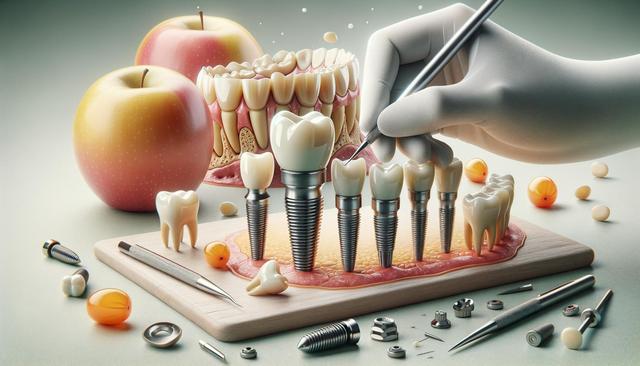Understanding Dental Implants
Dental implants are artificial tooth roots, typically made of titanium, that are surgically placed into the jawbone to support replacement teeth such as crowns, bridges, or dentures. This modern dental solution is designed to function, look, and feel like natural teeth. Unlike removable dentures or traditional bridges, implants are fixed in place and integrate with the bone, providing a stable and durable foundation for long-term dental rehabilitation. The process involves a thorough evaluation, planning, surgical placement, and a healing period before the final prosthetic is attached.
Patients considering dental implants often undergo diagnostic imaging, such as 3D scans or X-rays, to assess bone density and determine the best placement for the implant. While not everyone may be an ideal candidate, many individuals with sufficient bone and good oral health can benefit from this treatment. The technology behind implants has advanced significantly, making the procedure more predictable and accessible than ever before.
Benefits of Choosing Dental Implants
There are several advantages to choosing dental implants over other tooth replacement options. One of the most significant benefits is the preservation of jawbone integrity. When a tooth is lost, the bone in that area can begin to deteriorate over time. Implants help stimulate the bone, maintaining its strength and volume. Additionally, dental implants offer:
- Improved chewing ability and speech
- Natural-looking aesthetics
- No reliance on adjacent teeth for support
- Long-term durability with proper care
- Enhanced comfort without movement or slipping
Unlike removable braces, which are often used to align teeth and improve aesthetics, implants serve a restorative purpose. However, both can be part of a comprehensive dental treatment plan aimed at achieving a confident and functional smile.
Dental Implants vs. Removable Braces
While dental implants and removable braces serve different purposes, they can complement each other in a full-mouth rehabilitation plan. Removable braces are designed to correct misaligned teeth and bite issues, often as a precursor to restorative treatments. In contrast, implants are used to replace missing teeth or support dentures after teeth have been lost or extracted.
Patients undergoing orthodontic treatment with removable braces may later decide to replace missing teeth with implants once alignment is improved. This approach ensures optimal spacing and positioning, which can enhance the aesthetic and functional outcome of implant placement. Key differences between the two include:
- Removable braces are temporary and focus on alignment
- Dental implants are permanent and focus on tooth replacement
- Braces require regular adjustments, while implants involve surgical placement and healing
Combining these treatments can lead to a more complete smile transformation, especially for individuals who have both alignment and missing tooth concerns.
What to Expect During the Implant Process
The dental implant process typically involves several stages, each essential to ensuring the implant’s success and long-term stability. The initial consultation includes a comprehensive exam, medical history review, and imaging studies. Once suitability is confirmed, the surgical placement of the implant follows. This minor procedure is often performed under local anesthesia, and most patients report minimal discomfort.
After placement, a healing period known as osseointegration occurs, during which the implant fuses with the jawbone. This can take several weeks to a few months. Once integration is complete, an abutment is attached, followed by the final restoration, such as a crown or bridge. Throughout the process, maintaining good oral hygiene and attending follow-up appointments is crucial.
- Initial consultation and planning
- Surgical placement of the implant
- Healing and bone integration
- Attachment of the abutment and crown
Patients who previously used removable braces may appreciate the fixed and natural feel of implants, which eliminate the need for temporary appliances or adhesive-based dentures.
Maintaining Dental Implants for Long-Term Success
Like natural teeth, dental implants require consistent care to remain healthy and functional. Daily brushing and flossing, combined with routine dental check-ups, are essential to prevent complications such as peri-implantitis, a condition similar to gum disease. While implants are resistant to decay, the surrounding tissues can still be affected by poor oral hygiene.
To ensure long-term success, consider the following maintenance tips:
- Brush twice daily with a soft-bristled toothbrush
- Use floss or interdental brushes to clean between teeth and implants
- Visit your dentist every six months for professional cleanings
- Avoid smoking, which can compromise healing and implant stability
- Wear a nightguard if you grind your teeth
For those who previously used removable braces, transitioning to dental implants can bring a sense of permanence and confidence. While braces help align and enhance the smile, implants restore completeness, allowing individuals to enjoy their favorite foods and smile freely without concern.
Conclusion: A Comprehensive Approach to Smile Restoration
Dental implants offer a lasting solution for individuals seeking to replace missing teeth and restore oral function. When combined with orthodontic treatments like removable braces, they can be part of a holistic approach to achieving a balanced, beautiful smile. By understanding the benefits, process, and maintenance involved, patients are better equipped to make informed decisions about their dental health. Whether you’re exploring options after braces or looking to replace a lost tooth, dental implants provide a dependable and natural-looking solution that supports both aesthetics and functionality in the long run.











